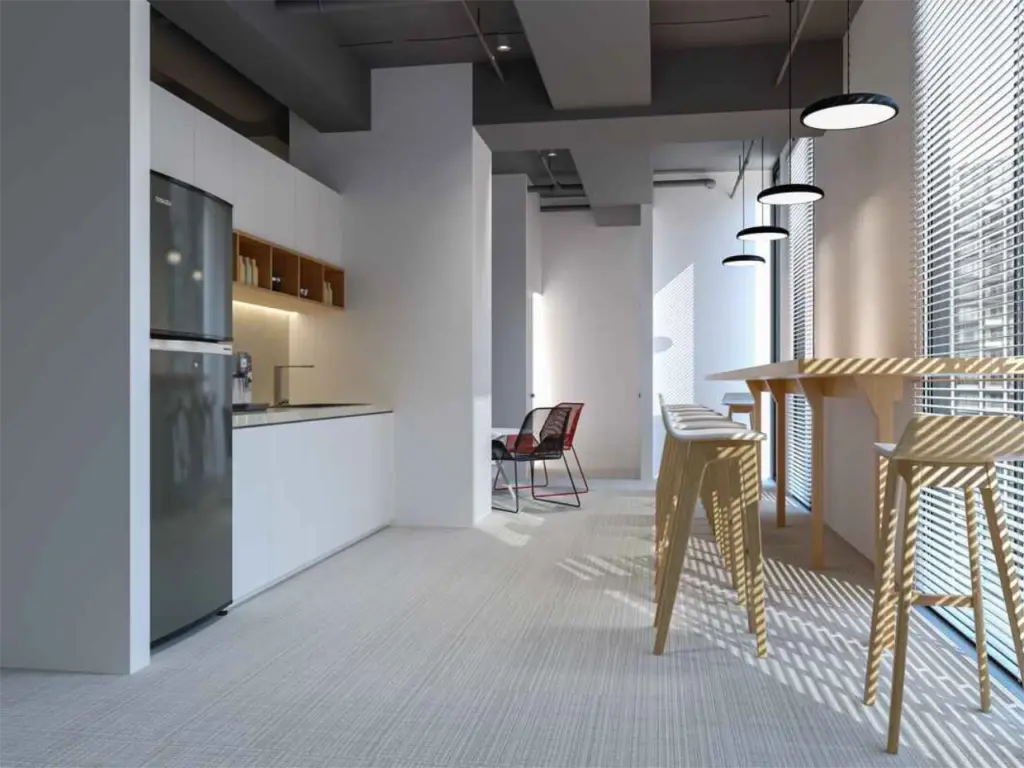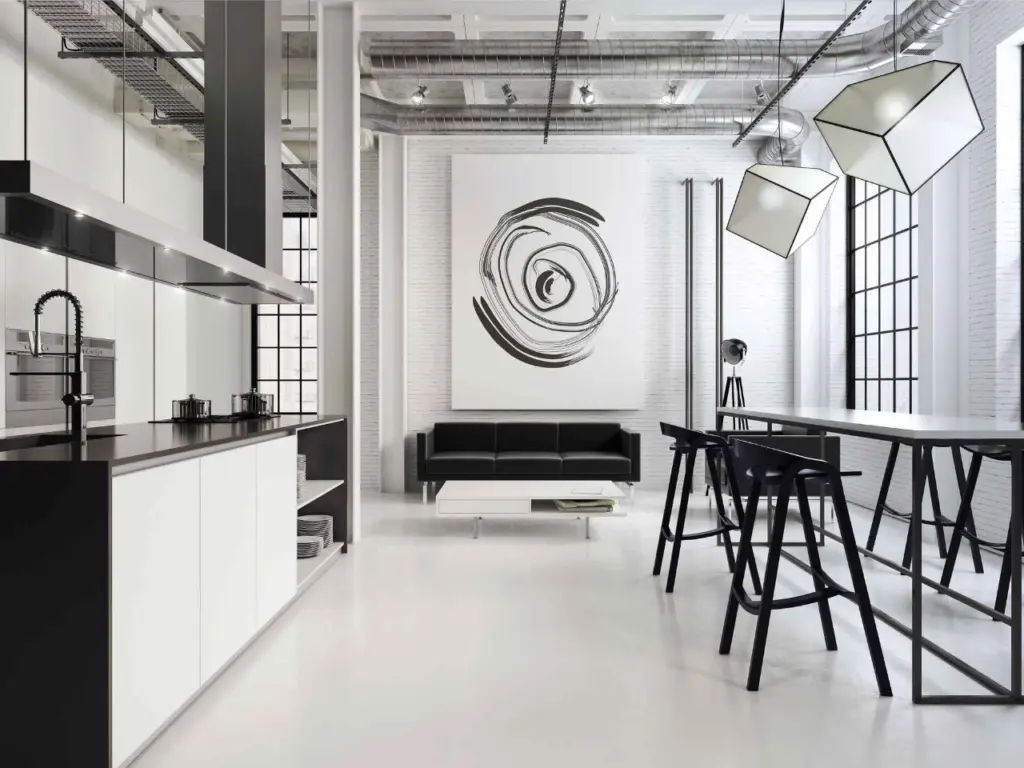Have you ever considered the role of an office kitchen in shaping workplace culture? In today’s fast-paced environment, the kitchen has become more than just a place for lunch; it’s a central hub for collaboration and creativity.
This article explores innovative office kitchen ideas that prioritize both functionality and style, helping to create a welcoming atmosphere where employees feel comfortable gathering, sharing ideas, and recharging.
From maximizing storage space to incorporating modern office kitchen design, you’ll surely find inspiration to transform your office kitchen interior into a vibrant space that boosts productivity and fosters a sense of community among employees.
The Role of an Office Kitchen in the Modern Workplace

An office kitchen plays a crucial role in today’s workplace or office design, providing more than just a spot to eat. It’s a hub for social interaction, productivity, and collaboration.
- Fostering a sense of community: A communal space like the office kitchen encourages casual conversations, helping to build relationships and strengthen workplace culture. It’s where employees can gather and connect, making the office feel more inclusive and welcoming.
- Encouraging breaks: The kitchen provides a designated area for lunch breaks and quick pauses, giving employees a chance to step away from their desks or workspace and recharge, resulting in enhanced focus and productivity.
- Supporting productivity: Equipped with essential appliances like a microwave, coffee maker, and dishwasher, a well-designed office kitchen makes meal prep quick and efficient, allowing employees to grab food or a beverage without disrupting their workflow.
- Boosting creativity and collaboration: The workplace kitchen is often the setting for impromptu conversations, sparking creativity and cross-departmental collaboration that may not happen in formal meetings.
- Promoting healthy habits: Offering a convenient cabinet storage. communal fridge, and fresh fruit, encourage employees to choose healthier meal options, promoting well-being and better energy levels.
A well-planned office kitchen is more than a utility—it’s a key part of creating a productive, healthy, and connected workplace environment.
Why Invest in a Well-Designed Modern Office Kitchen?

Investing in a well-designed office kitchen is important for modern workplaces aiming to foster a positive work environment and boost employee morale. Here’s why an office kitchen matters:
Boost Employee Satisfaction
A comfortable office kitchen helps employees feel valued, offering a space to relax and recharge during lunch and coffee or tea breaks. A meticulously designed kitchen can include amenities like a coffee maker, microwave, and ample storage space for personal items and communal snacks.
Encourage Collaboration and Team Spirit
An office kitchen serves as a central hub where team members gather for informal chats, fostering a sense of community and improving workplace culture. Shared kitchens fosters collaboration and allow employees from different departments to connect more casually.
Promote Health and Well-being
Providing healthy meal options, like fresh fruit in a communal fridge, encourages wellness. A cozy communal space allows employees to step away from their desks, promoting breaks that help them return recharged.
Enhance Productivity
An office kitchen minimizes the need for employees to leave for meals. Easy access to appliances like a microwave enables quick meal prep, reducing interruptions. It can also serve as a focal point for informal meetings, fostering creativity and collaboration.
Attract and Retain Talent
A thoughtfully designed office kitchen is a strong selling point for attracting and retaining talent. An inviting modern office kitchen enhances employee satisfaction and loyalty, making them feel appreciated in a supportive environment.
Foster a Positive Work Culture
A well-maintained office interiors including the kitchen reflects a company’s commitment to employee well-being. Creating a pleasant space for breaks fosters a positive atmosphere, contributing to a hygienic workplace that reduces stress.
Align with Sustainability Goals
Incorporating eco-friendly kitchen appliances like energy-efficient dishwashers and coffee machines supports sustainable practices. Using quartz countertops and easy-care surfaces promotes durability, while built-in storage for reusable utensils encourages environmentally friendly habits and reduces waste.
Maximizing Storage Space in Your Workplace Kitchen

Maximizing storage in your office kitchen is essential for enhancing functionality and organization. Here are effective strategies:
Utilize Vertical Space
Install shelves or cabinets that reach the ceiling to maximize vertical space in your office kitchen. Use the top shelves for infrequently used items, while open shelving allows easy access to everyday essentials, making your kitchen experience efficient.
Invest in Multi-Functional Furniture
Consider multi-functional furniture, such as tables with built-in storage or stools that double as storage units. These can provide extra space for utensils and kitchen appliances without taking up additional room in your workplace kitchen.
Optimize Cabinetry
Incorporate deep drawers or pull-out cabinets for efficient storage of kitchen appliances and utensils. Use drawer organizers to keep items sorted and easily accessible for quick meal prep, fostering a pleasant workspace.
Use Hooks and Racks
Install hooks or racks on walls to hang utensils, mugs, or pots. This frees up cabinet space and keeps frequently used items, like a coffee maker or microwave, within reach, promoting a functional modern office kitchen.
Create a Communal Storage Area
Designate a communal fridge or pantry for shared items, preventing overcrowding in individual storage areas. This encourages contributions to snacks and meals, enhancing the sense of community in your office kitchen.
Maximize the Fridge
Use organizers or bins in the fridge to keep items sorted. Clear containers help quickly identify contents, reducing clutter and ensuring a pleasant space for everyone during breaks.
Consider Built-In Solutions
Built-in options like lazy Susans or pull-out spice racks can maximize corner cabinet space in your office kitchen. These solutions enhance organization and accessibility for kitchen design.
Regularly Declutter
Schedule cleanouts to remove unused or expired items from the kitchen, keeping storage areas organized and making room for new supplies. A tidy workspace promotes efficiency.
Implement a Labeling System
Labels for pantry items and fridge contents streamline organization. This encourages employees to return items to their proper places, maintaining a tidy and functional office kitchen.
Foster Responsibility
Encourage employees to take responsibility for keeping the kitchen clean through a rotating cleaning schedule or clear guidelines for storage use. This fosters a sense of community and respect for shared spaces.
Appliances Should You Include in Your Modern Office Kitchen

Choosing the right appliance for your new office kitchen is essential to creating a fully functional workspace that meets everyone’s needs. Here are some must-have appliances you can include to your new office design idea
Coffee Maker
A coffee maker is a must-have for any office kitchen. It keeps employees energized and helps foster a welcoming atmosphere, encouraging social interactions during breaks.
Microwave
A microwave is essential for reheating meals and making quick snacks. Its convenience makes it a key appliance for busy workdays, allowing employees to enjoy hot food without leaving the office.
Refrigerator
A good fridge is vital for storing perishable items, beverages, and lunches. Go for a model with adjustable shelves to accommodate various items, from meal prep containers to drinks.
Dishwasher
Including a dishwasher promotes cleanliness and hygiene in the office kitchen. It saves time on cleanup, allowing employees to enjoy their meals without worrying about the mess afterward.
Electric Kettle
An electric kettle is great for preparing tea or coffee and instant meals. It’s efficient and allows employees to enjoy a warm beverage quickly, contributing to a cozy kitchen environment.
Water Dispenser
A water dispenser or cooler ensures employees have easy access to fresh drinking water. This promotes hydration and contributes to a healthier workplace.
Shared Kitchens: How to Foster a Sense of Community

Shared kitchens in the workplace go beyond meal preparation—they create a space that fosters interaction and a sense of community. A well-designed office kitchen encourages employees to gather, building stronger relationships and enhancing workplace culture.
To promote community, ensure the kitchen design has enough space and includes ample seating, such as high tables and stools, and essential kitchen appliances. These encourage shared meal times and social interaction, turning the kitchen into a hub. Tips for Fostering Community:
- Encourage shared contributions: A common fridge for snacks, fresh fruit, or potluck meals promotes collaboration.
- Design for inclusivity: Provide enough seating and storage space for everyone, ensuring a welcoming, pleasant space.
- Promote cleanliness: Accessible cleaning supplies like paper towels help keep the space tidy and inviting for all.
A well-maintained, meticulously designed shared kitchen enhances employee connections, fostering a sense of community within the workplace.
Design Ideas for a Modern Office Kitchen

Creating a modern office kitchen blends functionality, innovation, and style to enhance the workplace. Here are ten essential design ideas:
- Minimalistic and Clean Lines: Focus on sleek cabinet fronts and clutter-free worktops. Materials like quartz ensure durability and easy maintenance in a busy office kitchen.
- Tech-Savvy Features: Use smart appliances such as energy-efficient microwaves, coffee makers, and dishwashers. Electric kettles provide convenience, while built-in mini fridges help keep the space organized.
- Functional Storage Space: Enough or more storage is crucial. Use drawer systems and pull-out organizers to maintain a tidy and organized environment. Designate areas for communal items like a fridge and kitchen utensils for efficiency.
- Stylish Seating Areas: Use high tables with stools to promote interaction and informal meetings, fostering a sense of community and enhancing workplace culture.
- Flexible Communal Spaces: Make the kitchen a focal point for socialization. A well-designed area with versatile seating encourages employees to gather during lunch breaks, promoting relaxation.
- Fresh Fruit and Beverage Stations: Set up a designated spot for fresh fruit and beverages, encouraging healthy meal options and enhancing the kitchen’s inviting atmosphere.
- Hygienic Design Choices: Use easy-to-clean materials and surfaces to maintain hygiene. Installing a dishwasher helps with quick cleanup.
- Creative Lighting Solutions: Mix ambient and task lighting to create a warm atmosphere. Pendant lights over seating areas can serve as a stylish focal point.
- Eco-Friendly Elements: Integrate sustainable materials and energy-efficient appliances to promote environmentally friendly practices in the workplace.
- Pot and Utensil Organization: Use hanging racks for pots and utensils to keep them accessible, optimizing storage space and adding to the kitchen’s aesthetic.
These design ideas will ensure your modern office kitchen is a vibrant, functional space that encourages productivity and social engagement among employees.
Creating a Homely Yet Professional Modern Office Kitchen Experience
A modern office kitchen should strike the right balance between homeliness and professionalism, offering a space where employees can feel comfortable but still focused.
- Furnishing and design: Select homely furnishings like soft seating and warm lighting to create a cozy environment while maintaining a professional tone.
- Inclusive and pleasant space: A well-designed kitchen can make employees feel at home, promoting relaxation and encouraging them to step away from their desks during breaks.
- Sense of community: Fostering a sense of belonging is easier when the kitchen is designed with team spirit and collaboration in mind.
Why Efficient Storage and Organization Matter in a Workplace Kitchen
Efficient storage in an office kitchen is key to maintaining a productive and organized environment. When everything has its place, employees can focus on work without worrying about a cluttered kitchen.
- Cabinet and drawer organization: Well-organized cabinets and drawers make it easier for employees to find what they need, whether it’s utensils, pots, or pantry items.
- Designate specific areas: Ensure there are designated spaces for specific kitchen appliances and supplies like tea, coffee, and paper towels.
Tips for Keeping the Office Kitchen Clean and Hygienic
Maintaining a clean and hygienic office kitchen is essential for a healthy work environment. Here are key tips:
- Establish Cleaning Routines: Create a schedule for daily surface wipes and weekly deep cleaning of cabinets and utensils.
- Encourage Personal Responsibility: Remind employees to clean up after themselves and use the dishwasher.
- Designate Cleaning Supplies: Keep accessible cleaning supplies like disinfectant wipes and paper towels for quick cleanups.
- Implement a “Clean as You Go” Policy: Encourage cleaning while cooking to prevent messes.
- Schedule Regular Deep Cleaning: Organize monthly cleanings for often-overlooked areas, like the fridge.
- Use Easy-Care Surfaces: Choose materials like quartz that are easy to clean and durable.
- Manage Food Waste: Set up composting and ensure trash bins are emptied regularly.
- Monitor Shared Items: Regularly clean communal appliances and set usage guidelines.
- Promote Hygiene Practices: Encourage handwashing before and after using the kitchen and drying with paper towels.
- Create a Welcoming Environment: Use decor and plants to make the kitchen inviting.
Following these tips will help keep your office kitchen clean and hygienic, promoting a healthier workplace.
Final Thoughts
A well-designed office kitchen is important for enhancing workplace culture and productivity. By prioritizing functionality and style, you create an inviting space where employees can relax, collaborate, and recharge.
Incorporating smart storage solutions and essential appliances fosters efficiency, while a clean and welcoming environment promotes well-being.
Ultimately, investing in your office kitchen not only reflects your commitment to employee satisfaction but also transforms it into a vibrant hub that encourages creativity and community.
Frequently Asked Questions
What features should a large office kitchen include?
A large office kitchen should be meticulously designed to accommodate the needs of all employees. Consider these features:
Enough Storage: In addition to having enough cabinets and shelving for supplies, ensure there’s enough room for personal items.
Efficient Appliances: Include multiple fridges instead of just one to handle constant use and reduce the amount of time employees spend waiting for their food.
Flexible Seating: Provide various seating options to create a comfortable and inviting kitchen look.
Durable Surfaces: Use materials that can withstand spills and are easy to clean, ensuring the space remains tidy.
Natural Ventilation: Incorporating windows or ventilation systems helps keep the kitchen fresh, especially on hot summer days.
With these features, a large office kitchen can enhance employee satisfaction and efficiency.
How can I make my office kitchen more user-friendly?
Designing an office kitchen that is user-friendly can greatly improve the experience for touch device users. Here are some tips:
Clear Navigation: Arrange appliances and workstations logically, allowing employees to explore by touch without confusion.
Accessible Equipment: Position frequently used items at reachable heights to make it easier for everyone to access them.
Smart Design Elements: Consider using touchless devices for faucets and soap dispensers to promote cleanliness and ease of use.
Open Layout: An open layout fosters social interaction while providing enough space for several users at once.
Regular Maintenance: Ensure the kitchen is kept clean and well-stocked to encourage its use.
Taking these steps can make better use of your office kitchen space, benefiting all employees.
What is the importance of sustainability in modern office kitchen design?
Sustainability is a crucial aspect of modern office kitchen design. Here are key elements to consider:
Energy-Efficient Appliances: Choose appliances that reduce energy consumption, helping to keep operating costs down.
Eco-Friendly Materials: Use sustainable materials for countertops and cabinets that are easy to clean and maintain.
Waste Reduction: Implement recycling and composting bins to manage waste effectively and lessen the amount of garbage generated.
Water Conservation: Consider using low-flow faucets to save water and create a more environmentally friendly kitchen.
Healthy Choices: Provide options that promote healthy eating, also fostering a culture of wellness in the workplace.
By incorporating these elements, your office kitchen can serve as a model for sustainability.
How can modern office kitchens enhance employee collaboration?
Office kitchens often serve as informal meeting spots that foster collaboration among employees. Here’s how to enhance this aspect:
Open Spaces: Create an open layout that encourages employees to gather and interact during breaks.
Comfortable Seating: Include various seating arrangements that invite casual conversations and brainstorming sessions.
Visual Elements: Decorate the kitchen with inspiring artwork or quotes that spark creativity and dialogue.
Snack Stations: Provide snack stations with healthy options to encourage employees to take breaks together, making the kitchen a social hub.
Shared Resources: Ensure that the kitchen is stocked with shared resources like utensils and condiments, making it easy for everyone to feel at home.
By designing the kitchen as a collaborative space, you can encourage teamwork and camaraderie.
What should I consider when planning an office kitchen?
When planning an office kitchen, it’s important to address various needs and preferences. Here are essential considerations:
Space Allocation: Ensure that there is adequate space for cooking, dining, and socializing, allowing for multiple employees to use it at once.
Functionality: Focus on creating a layout that makes it easy to navigate and reduces the amount of time spent on meal prep.
Design Aesthetics: Choose a kitchen look that aligns with your brand and workplace culture, making it an attractive space to spend time in.
User Experience: Consider the needs of all employees, including touch device users, to ensure everyone feels comfortable and engaged.
Regular Upkeep: Plan for regular cleaning and maintenance to keep the kitchen looking its best and functioning efficiently.
Taking these steps allows you to take the first step towards creating an office kitchen that meets everyone’s needs.

